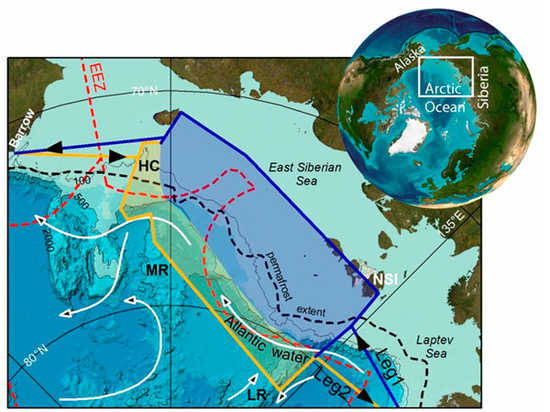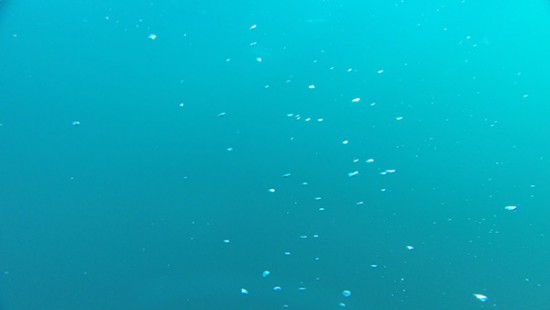Scientists discover vast methane plumes escaping from Arctic seafloor
“We are sniffing methane. We see the bubbles on video from the camera … All analysis tells the signs. We are in a [methane] mega flare.”

Methane mega flare event on the Laptev Sea slope of the Arctic Ocean, at a depth of about 62 meters. Image via Daily Kos via University of Stockholm.
An international team of scientists aboard the icebreaker Oden – currently north of eastern Siberia, in the Arctic Ocean – is working primarily to measure methane emissions from the Arctic seafloor. On July 22, 2014, only a week into their voyage, the team reported “elevated methane levels, about 10 times higher than background seawater.” They say the culprit in this release of methane, a potent greenhouse gas, may be a tongue of relatively warm water from the Atlantic Ocean, the last remnants of the Gulf Stream, mixing into the Arctic Ocean. A press release from University of Stockholm described the discovery as:
… vast methane plumes escaping from the seafloor of the Laptev continental slope. These early glimpses of what may be in store for a warming Arctic Ocean could help scientists project the future releases of the strong greenhouse gas methane from the Arctic Ocean.
The scientists refer to the plumes as methane mega flares.
Click here to see where the icebreaker Oden is right now.

Expedition of the icebreaker Oden – called the SWERUS expedition – preliminary cruise plan and study areas of Leg 1 and 2. EEZ=Exclusive Economic Zone; LR=Lomonosov Ridge; MR=Mendeleev Ridge; HC=Herald Canyon; NSI=New Siberian Islands. Image via Daily Kos via University of Stockholm.
On July 22, 2014, chief scientist Örjan Gustafsson of the University of Stockholm wrote about the methane mega flare event in his blog. He wrote:
So, what have we found in the first couple of days of methane-focused studies?
1) Our first observations of elevated methane levels, about ten times higher than in background seawater, were documented already as we climbed up the steep continental slope at stations in 500 and 250 meter depth. This was somewhat of a surprise. While there has been much speculation of the vulnerability of regular marine hydrates [frozen methane formed due to high pressure and low temperature] along the Arctic rim, very few actual observations of methane releases due to collapsing Arctic upper slope marine hydrates have been made. ¨
It has recently been documented that a tongue of relatively warm Atlantic water, with a core at depths of 200–600 meters may have warmed up some in recent years. As this Atlantic water, the last remnants of the Gulf Stream, propagates eastward along the upper slope of the East Siberian margin, our SWERUS-C3 program is hypothesizing that this heating may lead to destabilization of upper portion of the slope methane hydrates. This may be what we now for the first time are observing.
2) Using the mid-water sonar, we mapped out an area of several kilometers where bubbles were filling the water column from depths of 200 to 500 meters. During the preceding 48 hours we have performed station work in two areas on the shallow shelf with depths of 60-70m where we discovered over 100 new methane seep sites. SWERUS-C3 researchers have on earlier expeditions documented extensive venting of methane from the subsea system to the atmosphere over the East Siberian Arctic Shelf. On this Oden expedition we have gathered a strong team to assess these methane releases in greater detail than ever before to substantially improve our collective understanding of the methane sources and the functioning of the system. This is information that is crucial if we are to be able to provide scientific estimations of how these methane releases may develop in the future.
While not as long-lasting in the atmosphere as carbon dioxide, methane is much more effective than carbon dioxide at trapping heat in Earth’s atmosphere. Climate scientists discuss a potential feedback loop regarding methane’s role in global warming. That is, as Earth’s climate warms, methane that is frozen in reservoirs stored in Arctic tundra soils – or marine sediments – may be released into the atmosphere, where it warm Earth still more, releasing more methane, and so on.
Methane release from the Arctic Ocean is not a new phenomenon; after all, the Stockholm scientists were there to measure it. U.S. scientists have observed Arctic Ocean methane release, too. For example, NASA reported in April 2012 on a study in which scientists measured surprising levels of methane coming from cracks in Arctic sea ice and areas of partial sea ice cover.

Methane bubbles discovered on Laptev continental slope of Arctic Ocean by the science team aboard the icebreaker Oden. Image via University of Stockholm.
On July 23, Ulf Hedman – who is aboard the Oden and who is Science Coordinator for the Swedish Polar Research Secretariat – gave a vivid description of the discovery in his blog:
We are ‘sniffing’ methane. We see the bubbles on video from the camera mounted on the CTD or the Multicorer. All analysis tells the signs. We are in a [methane] mega flare. We see it in the water column we read it above the surface an we follow it up high into the sky with radars and lasers. We see it mixed in the air and carried away with the winds. Methane in the air. Where does it come from? Is it from the old moors and mosses that used to be on dry land but now has sunken into the sea. Does it come from the deep interior of the Earth following structures in the bedrock up into the sand filled reservoirs collecting oil and gas then leaking out upwards, as bubbles through the sea bed into the water, into the mid-water sonar, the Niskin bottles the analysis and into our results?
Where does the methane come from? Is it organic or not? What’s the volume? How much is carried up into the air? Is there an effect on the climate? One mega flare does not tell the truth. It’s not evidence enough.
We carry on for the next station.
And the next, and next, next…
Bottom line: A team of international scientists aboard the icebreaker Oden has documented “elevated methane levels, about ten times higher than in background seawater” in the Arctic Ocean. They are calling it a methane mega flare event and express hopes it will help them project future releases of the strong greenhouse gas methane from the Arctic Ocean, and to understand the role this released methane might play in global warming.

